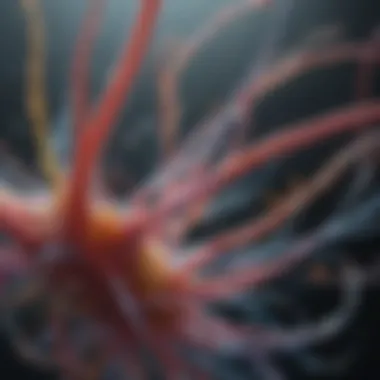Exploring the Constructal Law: Principles and Applications


Intro
The study of flow systems is crucial in various domains, ranging from biology to engineering. Understanding how these systems evolve and optimize is significant not just for academic purposes, but for practical applications as well. The Constructal Law serves as a fundamental framework for analyzing the design of flow systems. This principle suggests a deeper relationship between flow and design, proposing that systems evolve over time to facilitate easier and more efficient movement of substances.
In this article, we explore the essence of the Constructal Law. By examining its principles, relevant case studies, and implications across different scientific fields, we aim to provide valuable insights for students, researchers, and professionals interested in this compelling topic.
Foreword to Constructal Law
The Constructal Law offers a profound perspective on how natural and man-made systems evolve to optimize flow. This principle is particularly relevant in understanding the design and effectiveness of various systems across multiple disciplines. In this article, we will explore the underlying concepts of the Constructal Law, its historical development, and its applications in diverse fields.
At its core, the Constructal Law informs us that for a flow system to persist in time, it must evolve toward a configuration that maximizes flow access. This insight opens new avenues in the study of systems ranging from organisms to transportation networks. The implications of this law are far-reaching, providing significant benefits in both theoretical understanding and practical applications. As we uncover the major components of this law, it becomes evident that its utility lies not only in explaining existing phenomena but also in guiding future innovations.
Definition of Constructal Law
In simple terms, the Constructal Law states that the flow structures must evolve to facilitate the movement of currents, such as air, water, or even heat. This law allows researchers to design systems that are more efficient and effective in fluid flow. The law applies across many domains, including biology, engineering, and environmental science. Understanding this law can lead to improved designs, from vascular systems in living organisms to better fluid dynamics in engineering applications.
Historical Development
Theoretical foundations
Theoretical foundations of Constructal Law are robust and multifaceted. The primary characteristic revolves around the understanding of flow systems and their optimal shapes. One notable aspect is how it integrates principles from thermodynamics and evolutionary biology to explain how flow systems adapt and improve over time. This approach is beneficial for showcasing a practical framework in understanding complex systems. The unique feature of these theoretical foundations is their basis in real-world observations, making them critically relevant in various applications. However, the specific applicability of these models can sometimes limit their generalizability.
Pioneering researchers
The research community has been enriched by the contributions of several pioneering researchers who focus on the Constructal Law. Noteworthy individuals include Adrian Bejan, who played a crucial role in formalizing this law. Their work has resulted in a strong foundation and deeper insights into flow systems, making this a popular choice for researchers looking to explore the dynamics of natural phenomena. The pioneering efforts have drawn attention to the interconnectedness of systems, bringing forth a holistic view. Yet, the challenge remains in consistently applying these insights across varied contexts without oversimplifying the complexities involved.
Key milestones
Several key milestones have marked the development of the Constructal Law. One such milestone is the publication of seminal papers in the late 20th century that laid the groundwork for further exploration. These works highlighted the key characteristics of how systems adapt for optimal flow, making this a beneficial model for current and future research. Additionally, milestones have included interdisciplinary collaborations that broadened the scope of the law. The unique feature at these milestones is their potential to serve as a guide for advancing both fundamental and applied research. Meanwhile, ongoing evaluations of these milestones ensure continual refinement and understanding of the law's implications.
Fundamental Principles of Constructal Law
The Constructal Law indicates how flow systems organize and adapt over time. This concept has various fundamental principles that highlight its role in natural and artificial structures. Understanding these principles is crucial, as they help in explaining the efficient design and the flow of resources through systems. The principles serve as a foundation for numerous applications across multiple disciplines, from biology to engineering, showcasing their widespread relevance.
Flow Systems
Definition and characteristics
Flow systems refer to the manner in which resources, whether liquids or gases, navigate through structured frameworks. They have distinct characteristics, which include hierarchical organization and a tendency toward efficiency. These features are fundamental because they determine how effectively flow systems operate in various environments. The key characteristic is the ability of these systems to evolve and optimize their structure over time. This quality allows flow systems to be adaptable, which is advantageous in conditions requiring resilience.
Examples from nature
Nature provides numerous examples of flow systems that display the principles of the Constructal Law effectively. River networks, for instance, are classic examples that illustrate how water optimally flows through landscapes. Their branching structures optimize the distribution of water, showcasing efficiency in design. Another example is the vascular systems of plants and animals, which highlight the adaptability of flow systems in response to environmental pressures. These natural examples reinforce the validity of the Constructal Law as they demonstrate clear benefits in terms of optimization and resource distribution.
Optimization of Design
Energy efficiency
Energy efficiency is a crucial aspect of the optimization process in flow systems. This principle influences how structures are designed to minimize energy loss during the movement of resources. Systems that adhere to this principle often exhibit reduced waste, making operations more sustainable. The importance of energy efficiency lies in its ability to lower operational costs and extend the longevity of structures. Hence, it is a highly pertinent principle in discussing the Constructal Law.


Material distribution
Material distribution involves how materials are allocated and utilized within a flow system. An optimized distribution strategy leads to enhanced performance and reduced resource consumption. One of its key characteristics is its dynamism; the material arrangement adapts based on the flow requirements. This principle becomes beneficial for both natural ecosystems and engineered structures, as it promotes resilience and sustainability. Effective material distribution is, therefore, a vital topic when examining practical applications of the Constructal Law.
Adaptation and Evolution
The role of adaptation
Adaptation plays a significant role in the evolution of flow systems. It determines how these systems respond to changing environments. The centrality of adaptation in this context highlights the flexibility of structures as they adjust based on practical needs. It is a beneficial principle for products that require a long lifespan, as it fosters continuous improvement. Incorporating the role of adaptation enhances the understanding of how systems evolve and thrive.
Examples in biological systems
Biological systems frequently illustrate the concepts of adaptation and evolution. For example, the beak shapes of finches, which vary according to food sources, demonstrate how organisms adapt to ecological niches over time. These adaptations optimize the flow of energy and resources within those biological systems. Such examples are important as they validate the principles of the Constructal Law within the realm of biology, enhancing our comprehension of the interconnectedness between design and functionality.
Applications of Constructal Law in Various Disciplines
The Constructal Law finds relevance across multiple fields, influencing the understanding of flow systems and their optimization. This section explores critical applications in biology, engineering, environmental science, and medicine eacg providing a lens into how this law shapes our comprehension of diverse systems. The value of these applications lies in their ability to translate complex natural principles into practical designs and strategies for better efficiency and sustainability.
Biology and Ecosystems
Animal Morphology
Animal morphology illustrates how forms in nature develop based on optimal flow patterns. The characteristics of this aspect show how anatomy is shaped not only for survival but also for efficient resource use. An example includes the streamlined bodies of fish that minimize resistance in water. This design aspect enhances locomotion while conserving energy, making it a significant choice in exploring Constructal Law application. A unique feature is how these forms are adaptive; minor changes in environment or behavior can lead to different morphological outcomes. The advantages include improved energy efficiency, while a disadvantage may be limited versatility in other environments.
Flora and Fauna Interactions
Flora and fauna interactions represent another key aspect. These interactions can be understood through the lens of resource allocation and flow within ecosystems. Plants evolve in a way that optimizes nutrient uptake while animals may adapt to these changes in food sources or habitat structures. The collaborative dynamics of these interactions reveal the robust nature of ecosystems. A key characteristic is interdependence; all species rely on one another in some form. This aspect contributes to the broader understanding of stability and sustainability in ecosystems, though it can also lead to fragility if the balance is disrupted.
Engineering and Design
Fluid Dynamics in Engineering
In engineering, fluid dynamics represents a crucial aspect of Constructal Law application. The way fluids move and interact with boundaries informs optimal designs for systems ranging from pipelines to airfoils. Key characteristics involve the efficiency of transport and energy use. Engineers benefit from understanding these flow principles, leading to better performance and lower costs. The unique feature resides in its applicability to various scenarios, from single-phase to multi-phase flows. However, complexities in real-world applications may introduce challenges in modeling and prediction.
Architectural Applications
Architectural applications of Constructal Law can be seen in the design of buildings that optimize airflow and natural light. This design principle influences the shape and layout of structures, contributing to energy efficiency and aesthetic value. A characteristic feature is the integration of natural elements into built environments, promoting harmony between nature and human activity. This approach leads to smart designs that resist environmental forces. Nonetheless, the uniqueness of each location requires tailored solutions, which can complicate the design process.
Environmental Science
Ecosystem Management
In environmental science, ecosystem management leverages the Constructal Law to improve practices related to resource management and conservation. Understanding flow and interaction patterns helps in crafting strategies that maintain ecological balance. A primary characteristic is the focus on long-term sustainability. This perspective is beneficial as it considers the interconnectedness of species and their habitats. The complexity of natural systems can pose challenges in predicting outcomes of management practices, creating a need for adaptable strategies.
Climate Dynamics
In climate dynamics, the principles help explain how changes in flow systems can affect climate patterns. For instance, the movement of air masses and ocean currents plays a significant role in global weather. A key characteristic in this application is the emphasis on dynamic interactions between systems. Understanding these processes can lead to more accurate climate models. However, the highly variable nature of climate systems may introduce uncertainties, which complicates reliable forecasting.
Medicine and Physiology
Human Vascular System


The human vascular system serves as an example of Constructal Law application in medicine. Its design is optimized for efficient blood flow throughout the body. A notable characteristic is the branching structure, which minimizes resistance while promoting effective delivery of nutrients. This efficiency is crucial for maintaining health and responding to increased physical demand. However, underlying conditions can disrupt this system, highlighting challenges important to medical research.
Drug Delivery Mechanisms
Drug delivery mechanisms utilize principles from the Constructal Law to enhance the efficacy of therapeutic agents. An important aspect relates to how substances flow through biological systems, impacting absorption and distribution. The characteristic here is the precise control over dosing and timing, which has benefits in treating complex diseases. Yet, the need for personalization in drug delivery can complicate the implementation of these systems, making extensive research necessary to optimize outcomes.
Case Studies Illustrating Constructal Law
The exploration of case studies in the context of the Constructal Law is vital. These studies offer real examples where the principles of flow optimization manifest. They demonstrate how design and flow systems interconnect and influence one another. This section highlights both natural systems and technological innovations, showcasing the versatility and application of the Constructal Law across different domains. Examining case studies helps to solidify understanding and comprehension of theoretical concepts, making them relatable and easier to grasp for students and professionals alike.
Natural Systems
River networks as flow systems
River networks serve as a prime example of flow systems within the natural environment. The branching patterns of rivers and their tributaries can be seen as designs that maximize efficiency in transporting water from high elevations to lower ones. The key characteristic here is their fractal-like structure, which allows rivers to cover vast areas while minimizing energy loss during flow. This feature provides a beneficial aspect for this article, as it underscores how natural designs evolve towards optimal flow configurations.
A unique feature of river networks is their ability to adapt to changes in the environment, such as climate change or human intervention. While one might consider the disadvantages, like potential flooding from excessive rainfall, the advantages outweigh these concerns. The ability of river networks to change and optimize over time embodies the essence of the Constructal Law, illustrating how systems strive to enhance flow performance.
Animal migration patterns
The migration patterns of animals also exemplify the principles of the Constructal Law. During seasonal migrations, animals often follow specific routes that have been optimized over generations. The key characteristic of these pathways is their reliance on environmental cues, which guide animals to the most resource-abundant areas.
The beneficial choice of discussing animal migration in this article lies in the tangible examples it provides of adaptive behaviors in nature. Animals migrate to exploit resources efficiently, showcasing how living beings adapt their behaviors to optimize survival. A unique feature of these patterns is that they demonstrate a balance between instinctual navigation and environmental interactions. The advantage is evident in energy conservation during migration, while the disadvantage may be vulnerability to changing ecosystems and human impact.
Technological Innovations
Optimized heat exchangers
In engineering, optimized heat exchangers illustrate the Constructal Law principles effectively. These devices transfer heat between two or more fluids while minimizing energy loss. The key characteristic of optimized heat exchangers is their design, which ensures maximum surface area for heat transfer.
The benefit of including heat exchangers in this discussion stems from their widespread applications in sectors like HVAC and automotive. A unique feature of heat exchangers is their ability to change configurations based on operating conditions, thus improving energy efficiency. However, they may require substantial initial investment and regular maintenance, which are considerations to keep in mind.
Transportation systems
Transportation systems also reflect the optimization characteristics outlined by the Constructal Law. Highways, railways, and shipping routes provide the backbone for global connectivity and trade. The key characteristic is their network structure, designed to minimize travel time and distance.
Selecting transportation systems as a focus in this article is beneficial because they illustrate human-created flow systems aimed at optimizing efficiency. A unique feature of these systems is their scalability; they can adapt to growing populations and changing technologies. On the downside, issues like congestion and environmental impact must be acknowledged, necessitating ongoing improvements and adaptations to enhance flow performance.
Critiques and Challenges of Constructal Law
The Constructal Law, while offering significant insights into the design of flow systems, is not without its critiques and challenges. Understanding these limitations is essential for a balanced view of the law's applicability across disciplines. By delving into the critiques, one gains a clearer appreciation of its scope, the ongoing debates around integration with other theories, and the challenges in empirical validation. This discussion highlights the need for rigorous examination in scientific inquiry and contributes directly to the evolution of the Constructal Law.
Limitations of the Theory
Scope of applicability
The scope of applicability relates to the contexts in which Constructal Law can effectively be applied. It primarily addresses flow systems ranging from biological organisms to engineered structures. A vital aspect of this scope is that not all systems exhibit the same characteristics of flow or design optimization. Thus, the law may not fully describe systems that do not follow its underlying principles. For instance, turbulent flows may exhibit chaotic behaviors, resisting conventional optimization models. Despite this, the law's focus on flow systems remains its strong point, as it provides a framework to optimize various designs under specific conditions. Understanding its limitations encourages researchers to explore adaptations of the law for areas where fluid dynamics are less predictable. In summary, its applicability serves as a guide rather than an encompassing rule for all systems.
Specificity of models
The specificity of models within the Constructal Law reflects how tailored theoretical models must be to fit unique scenarios. Each application often requires consideration of various parameters, including environmental factors, material properties, and energy flows. The critical characteristic here is the importance of defining clear parameters for each model. The models that stem from the law provide valuable insights but can also limit broader understanding if over-specified. For example, while optimal heat exchanger designs can be derived from the law, they may not directly translate to more complex systems, such as those found in biological contexts. This specificity can be both beneficial and restrictive; it enables focused solutions but may hinder interdisciplinary applicability.


Ongoing Debates
Integration with other theories
The integration with other theories is a topic of considerable discussion among scientists and researchers. It focuses on how the Constructal Law can align or conflict with existing frameworks that explain flow systems. One key characteristic of this integration is the need to build a cohesive understanding with varying scientific paradigms, such as thermodynamics or evolution theories. Collaborative research can yield comprehensive perspectives, yet the challenge lies in reconciling differing methodologies and interpretations. This dynamic exchange can stimulate new ideas but also creates friction; some researchers argue that the law might oversimplify intricate systems in need of multi-faceted approaches.
Empirical validation
Empirical validation is a critical aspect of any scientific theory and the Constructal Law is no exception. Its contribution to understanding flow systems hinges on its ability to produce repeatable and observable predictions. The challenge, however, is that many proposed models have yet to undergo rigorous experimental testing in real-world scenarios. The unique nature of some systems can introduce variables that complicate validation. While there are examples where the law provides explanation and predictive power, skeptics note that further empirical studies are required to substantiate its broader applicability. This tension between theoretical framework and empirical evidence underscores the ongoing dialogue in the scientific community regarding the law's validity.
The advancement of the Constructal Law relies on both overcoming its limitations and engaging in productive debates within the scientific community.
Future Directions in Constructal Law Research
The Constructal Law offers vast potential for future explorations. Understanding its principles is crucial for grasping the evolution of flow systems. As research progresses, interdisciplinary approaches and technological integrations stand out as key driving factors for advancing this field. The nuances of these directions reveal new insights and applications that can significantly influence diverse areas from engineering to environmental science.
Emerging Trends
Interdisciplinary approaches
Interdisciplinary approaches are vital in the context of Constructal Law. This method combines knowledge from various fields to comprehend flow systems. It fosters collaboration among disciplines such as biology, engineering, and environmental science. By synthesizing diverse perspectives, researchers can enhance the understanding of complex systems. This collaborative essence is one of the key characteristics making interdisciplinary research a significant choice for this article.
The unique feature of this approach lies in its ability to merge theoretical and practical understandings. For example, insights from biology can inform engineering designs. In turn, engineering principles can shape our understanding of biological structures. However, navigating multiple disciplines can pose challenges, such as communication barriers and differing methodologies. Despite these difficulties, the advantages, such as innovative solutions, often outweigh the drawbacks.
Technological integration
Technological integration is another crucial element in advancing the Constructal Law. It involves applying modern technology to the principles of flow systems. This can mean using software for simulations, sensors for data collection, or artificial intelligence for optimization. The key characteristic of tech integration is its ability to enhance accuracy in modeling flow systems. This is particularly useful in disciplines such as engineering and environmental management.
The unique aspect of this integration is its potential to predict and optimize designs effectively. For instance, using AI for predictive modeling can lead to more efficient engineering solutions. However, reliance on technology can sometimes lead to oversimplifications. It is important to balance technological applications with theoretical frameworks to mitigate such risks. Overall, technological integration remains a beneficial choice, bringing precision and efficiency to the study of Constructal Law.
Potential Applications
Smart materials
Smart materials represent a significant area where Constructal Law principles can be applied. These materials can adapt to their environment, making them valuable in various applications. Their key characteristic is responsiveness to stimuli such as temperature or pressure. This adaptability enhances the efficiency and performance in systems designed based on Constructal Law principles.
A unique feature of smart materials is their ability to self-adjust. For example, in biomimetic designs, smart materials can imitate natural flow systems, improving efficiency in engineering contexts. However, the complexity of integrating such materials can be a limitation. The benefits must be carefully weighed against the challenges in production and implementation.
Renewable energy systems
Renewable energy systems are another promising application area. They play a critical role in addressing global energy challenges. The key characteristic of renewable energy systems is their potential for sustainability, aligning closely with the principles of optimizing flow. They are seen as beneficial choices for promoting ecological balance and reducing carbon footprints.
A unique feature of these systems is their dynamic nature. They can adapt to changes in energy demands and available resources. However, the initial costs and resource requirements can be obstacles. Long-term benefits generally exceed these initial challenges, underscoring the importance of integrating Constructal Law principles in developing renewable energy systems.
Finale and Implications
The Conclusion and Implications section serves as a pivotal element of this article, distilling the insights garnered from the exploration of the Constructal Law. It emphasizes the law's essential role in bridging the disciplines of biology, engineering, environmental science, and medicine. The synthesis of findings from various sections provides a comprehensive understanding of how the Constructal Law applies to and influences diverse systems across nature and technology.
Summary of Key Insights
The discussion highlights several key insights that emerge from the analysis of the Constructal Law:
- The law demonstrates that flow systems evolve to optimize their performance, fundamentally transforming our understanding of design in natural and artificial systems.
- Real-world examples, such as river networks and human vascular systems, illustrate the practicality of the Constructal Law. These examples showcase how organisms and structures adapt over time for better efficiency.
- The interdisciplinary applications of this law extend beyond traditional boundaries, fostering innovative design principles that can be used in engineering and environmental science. Constructal theory drives forward advancements in fields such as fluid dynamics and ecosystem management.
- There is a clear connection between the evolutionary adaptations of biological systems and engineered systems, suggesting that nature’s designs can inspire technological innovations.
Final Thoughts on Constructal Law
Ultimately, the implications of the Constructal Law extend into the future, encouraging an emphasis on innovation that is aligned with the natural principles evident in the world around us. This exploration lays the foundation for additional research, guiding future scientists, engineers, and educators to recognize the inherent design dynamics of flow systems in their respective fields.







